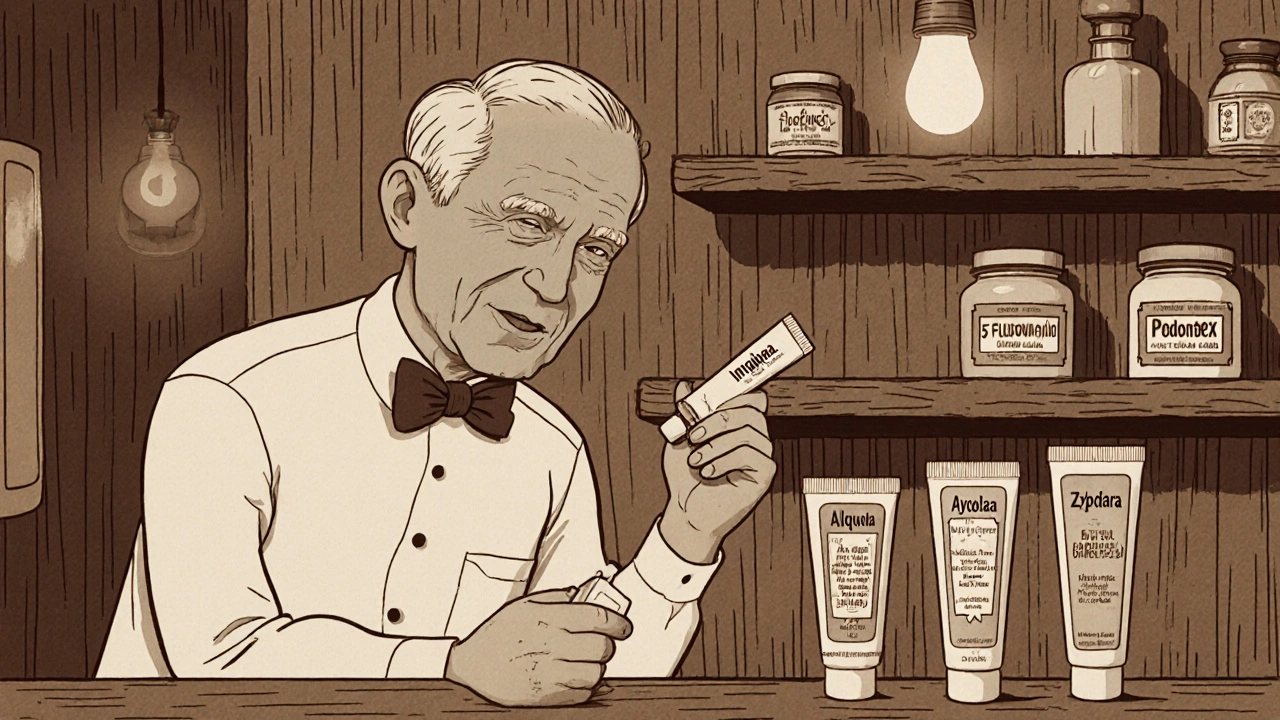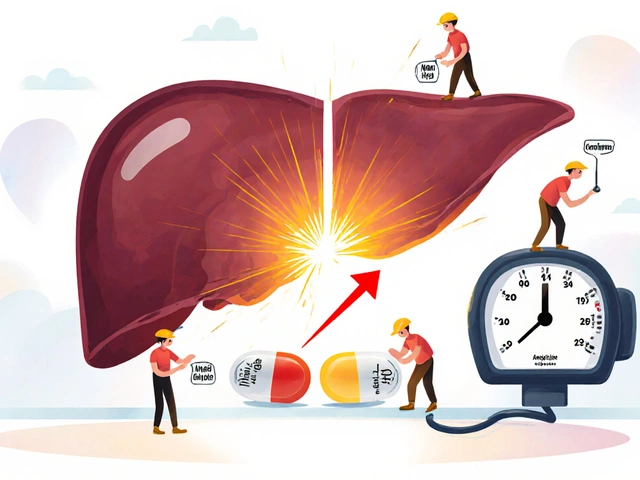
Skin Treatment Selector
Find the Best Treatment for You
Select your specific needs to see which treatments match your situation.
Recommended Treatments
Best Options for You
| Product | Active Ingredient | Application | Cost (UK) | Best For |
|---|
When you’ve been told you need a prescription cream for a skin lesion, the market can feel overwhelming. You might wonder whether Imiquad Cream is the right choice or if another option would suit you better. This guide walks through how Imiquad works, what conditions it treats, and how it stacks up against the most common alternatives.
What is Imiquad Cream?
Imiquad Cream is a prescription topical medication that contains 5% imiquimod, an immune response modifier. It was approved in the UK in 2009 for actinic keratosis and later expanded to treat superficial basal cell carcinoma and external genital warts.
How Imiquad Works
Imiquimod activates toll‑like receptor 7 on skin immune cells, which triggers the release of cytokines such as interferon‑alpha, tumor necrosis factor‑alpha, and interleukins. This boost in local immune activity helps the body recognize and destroy abnormal skin cells.
Conditions Treated with Imiquad
- Actinic keratosis - rough, scaly patches caused by sun damage.
- Superficial basal cell carcinoma - early‑stage skin cancer confined to the top layer.
- External genital warts - caused by low‑risk HPV strains.
Popular Alternatives to Imiquad
Several other topical agents address the same conditions, each with its own pros and cons.
Aldara is another brand of imiquimod, marketed primarily in the United States. Its active ingredient and mechanism are identical to Imiquad, but the formulation differs slightly, leading to minor variations in tolerability.
Zyclara delivers a higher 7.5% concentration of imiquimod, approved for severe actinic keratosis and larger field treatments. The higher dose can mean faster clearance but also more intense skin reactions.
Podofilox Cream (active ingredient podophyllotoxin) targets genital warts by disrupting cell division. It’s not used for actinic keratosis.
5‑Fluorouracil Cream is a chemotherapy agent that interferes with DNA synthesis in rapidly dividing cells. It’s effective for actinic keratosis and superficial basal cell carcinoma, but it often causes ulceration.
Ingenol Mebutate Gel (commercially sold as Picato) works by inducing rapid cell death followed by an immune response. It’s a short‑course treatment (2-3 days) but can be painful.
Diclofenac Gel is a non‑steroidal anti‑inflammatory drug applied twice daily for up to three months. It’s gentle on the skin but slower to clear lesions.
Tretinoin Cream (retinoic acid) promotes skin turnover and is used off‑label for actinic keratosis. It’s inexpensive but may cause irritation.

Side‑Effect Profile Comparison
| Product | Typical Local Reactions | Systemic Risk | Typical Duration of Side Effects |
|---|---|---|---|
| Imiquad Cream | Redness, crusting, itching | Rare - flu‑like symptoms | Weeks after treatment ends |
| Aldara | Similar to Imiquad, slightly higher burning | Very rare | 1-2weeks post‑treatment |
| Zyclara (7.5% imiquimod) | More intense erythema, swelling | Low | Up to 3weeks |
| Podofilox Cream | Severe irritation, ulceration | Negligible | 2-4weeks |
| 5‑Fluorouracil Cream | Ulceration, crusting, pain | Very low | Up to 6weeks |
| Ingenol Mebutate Gel | Burning, blistering | Minimal | 1-2weeks |
| Diclofenac Gel | Mild erythema, itching | Minimal | Several weeks, gradual |
| Tretinoin Cream | Dryness, peeling | Negligible | Weeks to months |
Direct Feature Comparison
| Attribute | Imiquad Cream | Aldara | Zyclara | 5‑Fluorouracil | Ingenol Mebutate | Diclofenac Gel | Podofilox |
|---|---|---|---|---|---|---|---|
| Active ingredient | Imiquimod 5% | Imiquimod 5% | Imiquimod 7.5% | 5‑Fluorouracil 5% | Ingenol mebutate 0.015% (face) / 0.045% (scalp) | Diclofenac 3% | Podophyllotoxin 0.5% |
| Approved indications | Actinic keratosis, superficial BCC, genital warts | Same as Imiquad (US market) | Severe actinic keratosis, field cancerization | Actinic keratosis, superficial BCC | Actinic keratosis (face/scalp) | Actinic keratosis (face) | Genital warts |
| Application frequency | 5 days/week for 4-16 weeks | 5 days/week for 4-16 weeks | 5 days/week for 2-4 weeks | Twice daily for 2-4 weeks | Once daily for 2-3 days | Twice daily for up to 3 months | Twice daily for 3 days, repeat after 1 week |
| Typical cost (UK) | £70‑£90 per 5‑g tube | £80‑£95 per tube | £100‑£120 per tube | £40‑£60 per tube | £150‑£180 per 2‑g sachet | £30‑£45 per 30‑g tube | £45‑£55 per 2‑g tube |
| Prescription required | Yes | Yes | Yes | Yes | Yes | Yes | Yes |
Choosing the Right Option for You
Consider these factors when deciding between Imiquad and an alternative:
- Lesion type and size - Larger fields benefit from higher‑dose imiquimod (Zyclara) or brief but potent agents like ingenol mebutate.
- Tolerance for skin reactions - If you’ve struggled with severe redness, a milder option such as diclofenac may be preferable.
- Treatment duration - Short courses (ingenol mebutate) suit busy schedules, while longer regimens (Imiquad, 5‑fluorouracil) demand patience.
- Cost and insurance coverage - Imiquad sits in the mid‑range; generic 5‑fluorouracil often costs less.
- Doctor’s experience - Some dermatologists have a bias toward the drug they’ve used most successfully.

Practical Tips for Using Imiquad Effectively
- Apply a thin layer to clean, dry skin. Do not cover the area with dressings unless instructed.
- Wash your hands before and after each application. \n
- Track the treatment calendar; missing more than two consecutive days may reduce efficacy.
- Use gentle moisturizers on surrounding skin to lessen dryness, but avoid applying directly on the lesion.
- If severe irritation develops, pause treatment and discuss dose adjustment with your clinician.
Common Pitfalls and How to Avoid Them
Many patients stop Imiquad too early because the lesions look better after a few weeks. The immune response needs the full course to eradicate hidden abnormal cells. Set reminders and keep the prescription handy.
Another mistake is applying the cream on open wounds. This can increase systemic absorption and cause flu‑like symptoms. Always wait until the skin is intact before each dose.
When to Seek Professional Advice
If you notice persistent fever, severe swelling, or lesions that worsen despite treatment, contact your dermatologist promptly. These signs could indicate an infection or an atypical reaction requiring a different therapy.
Frequently Asked Questions
How long does it take for Imiquad to clear actinic keratosis?
Most patients see visible improvement after 4‑6 weeks, but the full course (typically 4‑16 weeks) is needed to ensure complete clearance.
Can I use Imiquad on facial skin?
Yes, Imiquad is approved for facial actinic keratosis. Use a very thin layer and monitor for excessive redness, especially around the eyes.
Is Imiquad more effective than 5‑Fluorouracil?
Clinical studies show similar clearance rates, but Imiquad often causes less ulceration. Patient preference usually drives the choice.
What should I do if I miss a dose?
Apply the missed dose as soon as you remember, unless it’s close to the next scheduled application. In that case, skip the missed dose and continue the regular schedule.
Are there any drug interactions with Imiquad?
Topical imiquimod has minimal systemic absorption, so interactions are rare. However, avoid using other irritating topicals (e.g., retinoids) on the same area without medical guidance.




Emily (Emma) Majerus
October 16, 2025 AT 18:38Just wanted to say you did a solid job breaking down Imiquad vs the others – it’s super helpful for anyone feeling lost. Keep it up!
Miriam Rahel
October 17, 2025 AT 21:02While the overview is indeed comprehensive, the omission of pharmacokinetic data for imiquimod derivatives could be perceived as a lacuna. Moreover, the comparative cost analysis would benefit from inclusion of NHS reimbursement rates. Nonetheless, the manuscript remains a valuable resource for clinicians.
Frank Diaz
October 18, 2025 AT 23:26It is intriguing how the dermatological community gravitates toward topical immunomodulators as if seeking a panacea for cutaneous neoplasia. Yet the reality is that each molecule carries its own philosophical burden of inflammation and patient compliance. One must contemplate whether the pursuit of clearance justifies the inevitable erythema that follows.
Mary Davies
October 20, 2025 AT 01:50Oh, the drama of red patches! It's like a theatrical performance where the skin takes center stage, screaming for attention while we merely watch. I can almost hear the applause of the immune system as it battles those rogue cells.
Valerie Vanderghote
October 21, 2025 AT 04:14Okay, let me just vent for a minute because honestly this whole imiquimod saga feels like a soap opera that never ends.
First off, the side‑effects are not just “redness” – they’re a full‑blown skin rebellion that makes you question your life choices.
I’ve seen friends apply the cream and then spend hours in front of the mirror, dissecting every speck of crust as if it were a crime scene.
It’s wild how a prescription can turn a simple routine into an emotional rollercoaster, complete with anxiety spikes and midnight Google searches.
And don’t even get me started on the cost; the pharmacy bill alone feels like a silent accusation that you’re not worthy of clear skin.
When you read the table comparing Imiquad to Zyclara, you can almost hear the whispers of “maybe I’m not cut out for this” echoing in your head.
People often forget that the “prescription required” label also means a gatekeeper – your dermatologist – who decides whether you’re brave enough for the burning.
In my experience, the “gentle” option like diclofenac is a lie told by marketers to keep us complacent.
Sure, it’s mild, but it drags on for months, turning patience into a virtue you’re forced to cultivate.
Meanwhile, the high‑dose Zyclara promises faster results, yet delivers a firestorm that could rival a summer heatwave on your face.
It’s a trade‑off that feels less like a medical decision and more like gambling at a high‑stakes casino where your skin is the chips.
I’ve even caught myself comparing my treatment plan to a military strategy, assigning troops (cream), battlefields (lesions), and casualty reports (redness).
By the time the regimen ends, you’re left with a scarred timeline of appointments and a lingering fear that the next flare will be even worse.
Honestly, the whole process forces you to confront your own resilience, and that’s not something a brochure can explain.
So, if you’re about to start Imiquimod, brace yourself for not just a medical journey but an emotional saga that will test the limits of your skin and spirit.
Michael Dalrymple
October 22, 2025 AT 06:38Thank you for articulating the patient‑centred challenges with such clarity; your narrative underscores the importance of comprehensive counseling prior to initiating imiquimod therapy. I concur that setting realistic expectations can mitigate emotional distress.
Virginia Dominguez Gonzales
October 23, 2025 AT 09:02Wow, this guide is like a lighthouse in a sea of confusing creams – it shines bright and points the way to smoother skin! Your effort really shines.
Samantha Oldrid
October 24, 2025 AT 11:26Oh great, another “lighthouse” – because we all needed more glowing metaphors.
Kate Marr
October 25, 2025 AT 13:50Honestly, the UK’s pricing for Imiquad feels like a sneaky way to keep us from getting top‑tier skin care – guess we’ll have to support our own 🇺🇸 solutions instead.
James Falcone
October 26, 2025 AT 15:14Exactly, why should we pay extra for foreign meds when our own pharmacies can crush the competition? Let’s keep the market home‑grown.
Darryl Gates
October 27, 2025 AT 17:38Excellent breakdown; the tables make the differences crystal clear, especially regarding treatment duration and side‑effect timelines.
Carissa Padilha
October 28, 2025 AT 20:02Sure, the tables look clean, but have you ever wondered why certain data points are missing? Some say the pharma giants pressure clinicians to hide the long‑term effects. It’s all a façade.
Richard O'Callaghan
October 29, 2025 AT 22:26Man, I gotta say these creams are kinda scary – especially when you think about all the chemicals they pump into your skin. Just be careful, okay?